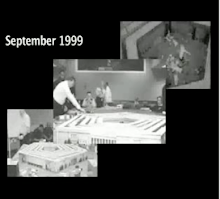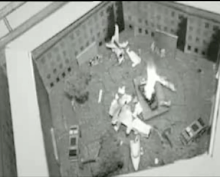.... "accurately replicating a population's reactions to the various non-combat aspects of global combat operations"

(Copied & pasted as original page not up on web at USJFCOM any more. Emphasis added to key concepts)
A newly developed modeling software prototype may allow joint warfighters to add realism to real world scenarios by accurately replicating a population's reactions to the various non-combat aspects of global combat operations.
By Army Sgt. Jon Cupp
USJFCOM Public Affairs
(SUFFOLK, VA -- Feb. 6, 2004) - How far would U.S. Joint Forces Command go to evaluate a computer simulation that models human behavior and emulates demographic information of a population?
Representatives of USJFCOM's Joint Experimentation (J9) and the Joint Training Directorates (J7) answered that question recently as they traveled to West Lafayette, Ind. to work with researchers, engineers and developers from a major university to evaluate a proof of concept: a Web-based collaborative computer simulation which mimics human behavior and the responses of the population, during various real-world scenarios, in real time.
More than 30 USJFCOM participants, along with representatives from Purdue University's Krannert School of Management evaluated military applications using a prototype of the Synthetic Environments for Analysis and Simulation (SEAS) at the Purdue Technology Park from Jan. 27-28 during Breaking Point 2004, an environment-shaping war game.
During the exercise, and to demonstrate the capability war game organizers distributed the simulation and the after action review back to J9 participants in Suffolk.
Participants during the event also included representatives from major U.S. corporations such as IBM and several retired senior military officers.
“We've been looking very hard for a simulation that will address the non-kinetic aspects of combat, things like the diplomatic, economic, political, infrastructure and social issues,” said Rae Dehncke, the SEAS project officer at J9 and a member of the staff at the Institute for Defense Analyses (IDA).
“We asked (Purdue) to adapt their current simulation to a military situation,” added Dehncke. “What makes SEAS unique is that it is an agent-based simulation in which artificial agents with-in the simulation actually represent the population of a city, or a country. or the human players can represent members of an agency, such as the Department of Defense, the media, terrorists, governments of a city, or country as well as, in this case, representatives of world health organizations. Human actors actually interact with each other and with the simulation and the artificial agents in the simulation are responding to their inputs.”
Participants in the exercise played on different color-coded teams with the blue team representing the U.S. Department of Defense, the U.S. State Department, and the World Health Organization.
There were two green teams with one representing another country's president and the ministries of transportation, internal affairs and health, while the second green team represented that country's capital city's government to include the mayor and the departments of transportation, internal affairs and health.
Meanwhile, a red team portrayed the role of terrorists operating in the green team's territory. [Who is considered a "terrorist" ?]
According to Dehncke, something new this war game brought to the experimental venue involved yet another set of teams influencing the scenario. The yellow team represented two separate media teams, one representing the pro-blue media while the other team represented pro-red journalists. “It's very important to play the impact of these media organizations and they definitely influenced the human players and the artificial agents within the simulation,” said Dehncke.
All of the players in the scenario had input devices that interacted with the simulation, and allowed interaction with other players using email or talking directly to each other just as they would in the real world.
Some of the ways in which players influenced the scenario included the blue-team's military ability to close and open air spaces and their ability to do a show of force or the red-team's terrorist activities of delivering weapons of mass destruction or spreading rumors just to name a few. [Are rumors of questions about US Government statements deemed subversive]
All players had the ability to influence the game, and each player had a finite amount of resources with which to work and he had to take from one to give to another. According to Dehncke, a key part of this simulation allowed players to actually see quickly the results of actions and how it affects the population, a helpful training aid in practicing how to make good decisions.
Throughout the game, output devices allowed role players to see how well they are doing in influencing the population.
“They show the measures of output like little thermometers,” said Dehncke. “For instance, you will be able to see if the public mood is good or bad, and if the people's satisfaction with the government is high or low. You can tell how the people are reacting, whether they're ready for a revolution or if they're going to vote for the government again.”
According to Dehncke, SEAS technology resulted from ten years of research conducted at Purdue's Krannert School of Management. In addition, the National Science Foundation, the 21st Century Fund of the state of Indiana, the The Department of Defense and several Fortune 500 companies has provided funding for the program. Office of Naval Research and companies such as Intel supported SEAS through funding of over $7 million.
Originally, SEAS was built by the Krannert School to help Fortune 500 companies with strategic planning. Most recently, it has been incorporated into the U.S. Army's recruiting efforts by modeling the population of the U.S. that is eligible for military service, thus allowing recruiting commanders to strategize ways to improve recruiting potential soldiers.
“What we would like to do in the future is run this exercise from Purdue on their hardware and distribute it to all the player sites.” said Dehncke. “We could have the real inter-agency organizations involved, like the FBI, the Treasury Department and the State Department, playing from their desks at their home offices around the country.
"This is about the non-combat aspects of war so it is very important that all the agencies normally involved in supporting the war fighters have the ability to participate and make their inputs into the overall decision-making process. SEAS moves us from the current situation where everyone comes together and sits around a table discussing what they would do, to a situation where they actually play in the simulation and their actions have consequences.”
One of the purposes of the exercise was to figure out how to adapt SEAS for use within USJFCOM.
“The only question now is what does it cost, how hard is it to set up, and how hard is it to create the scenarios,” said Dehncke. “These are some of the things that we're looking at right now as we look ahead to the potential uses of SEAS.”
According to Tony Cerri, the senior government official from JFCOM who attended the event at Purdue, USJFCOM is currently researching the possible use of the SEAS simulation in combination with current technologies at J9 such as the Scalable Parallel Processor (SPP), a super computer that is currently being used to support an experiment on joint urban operations and which could be used to host the SEAS simulation for large scale events.
Additionally, Cerri said J9 will examine if the Collaborative Information Environment (CIE), and the Distributed Continuous Experimentation Environment (DCEE) could work with SEAS.









